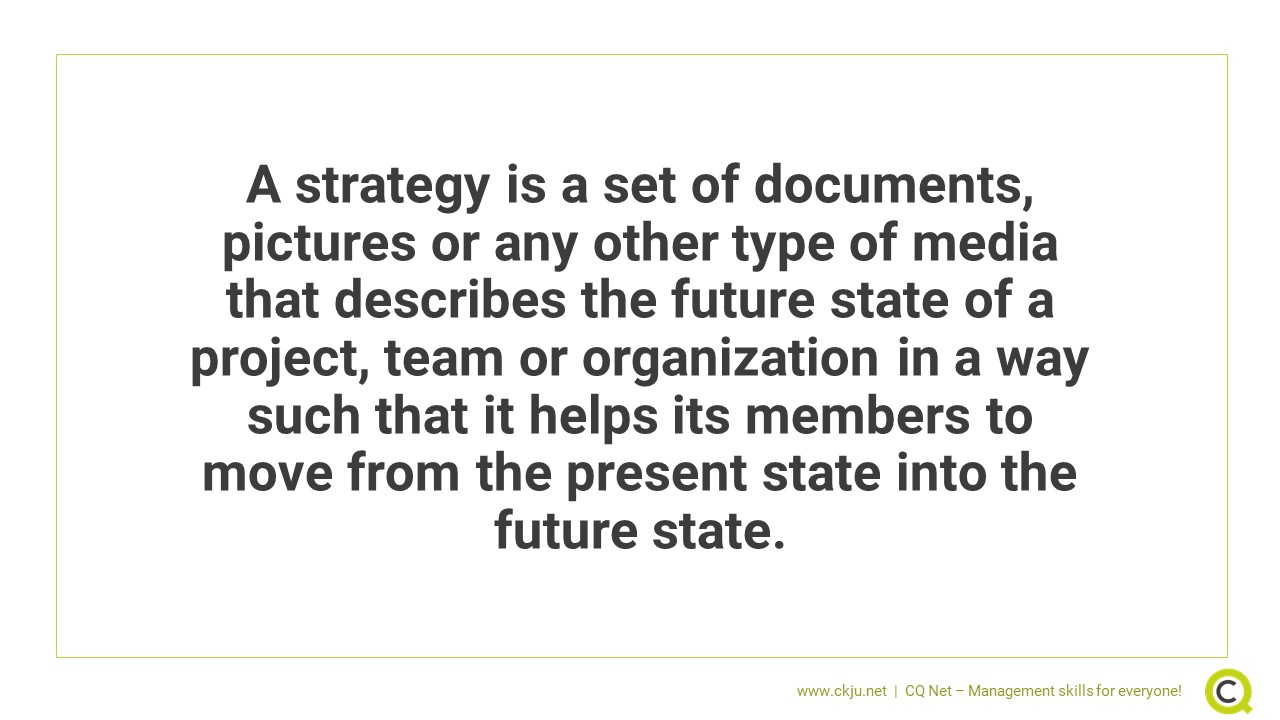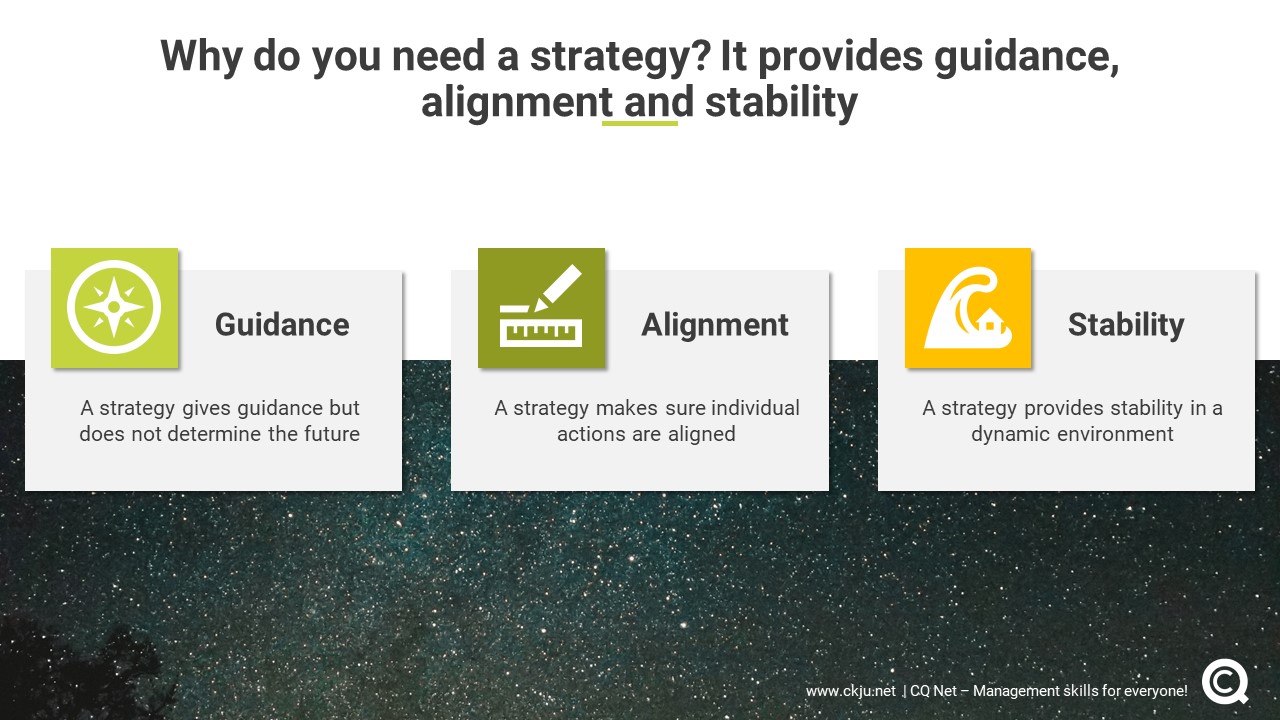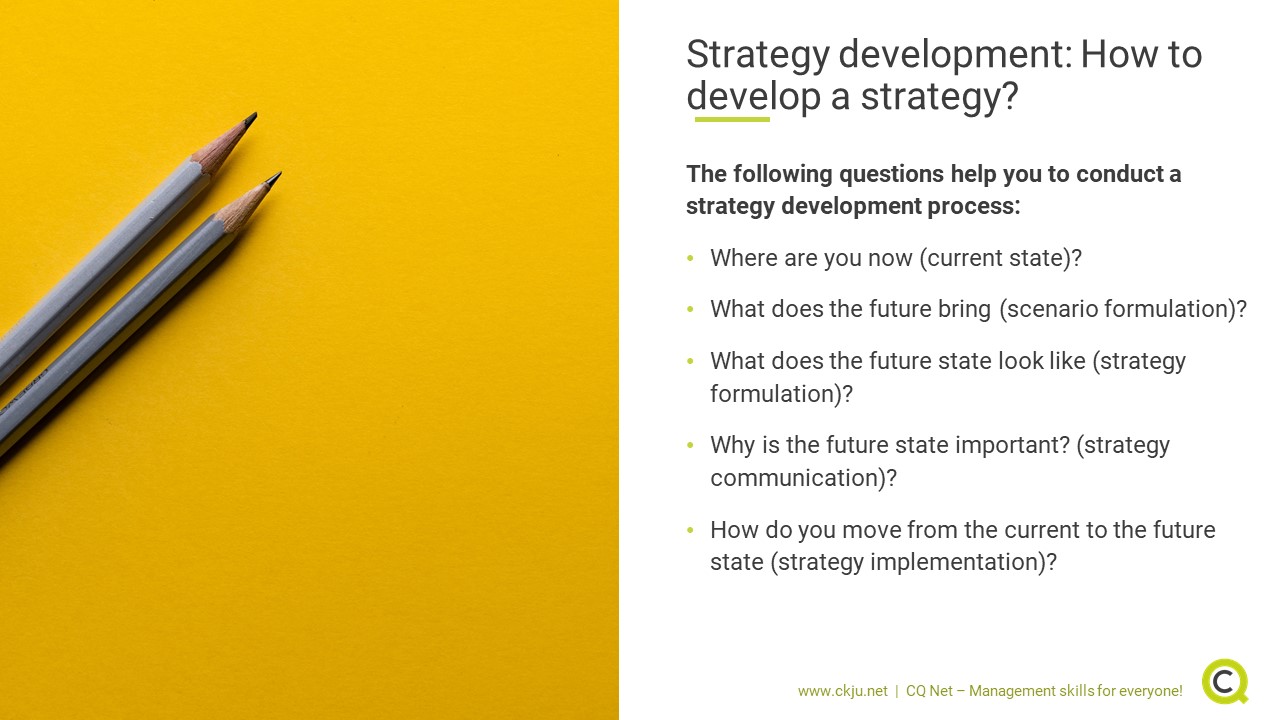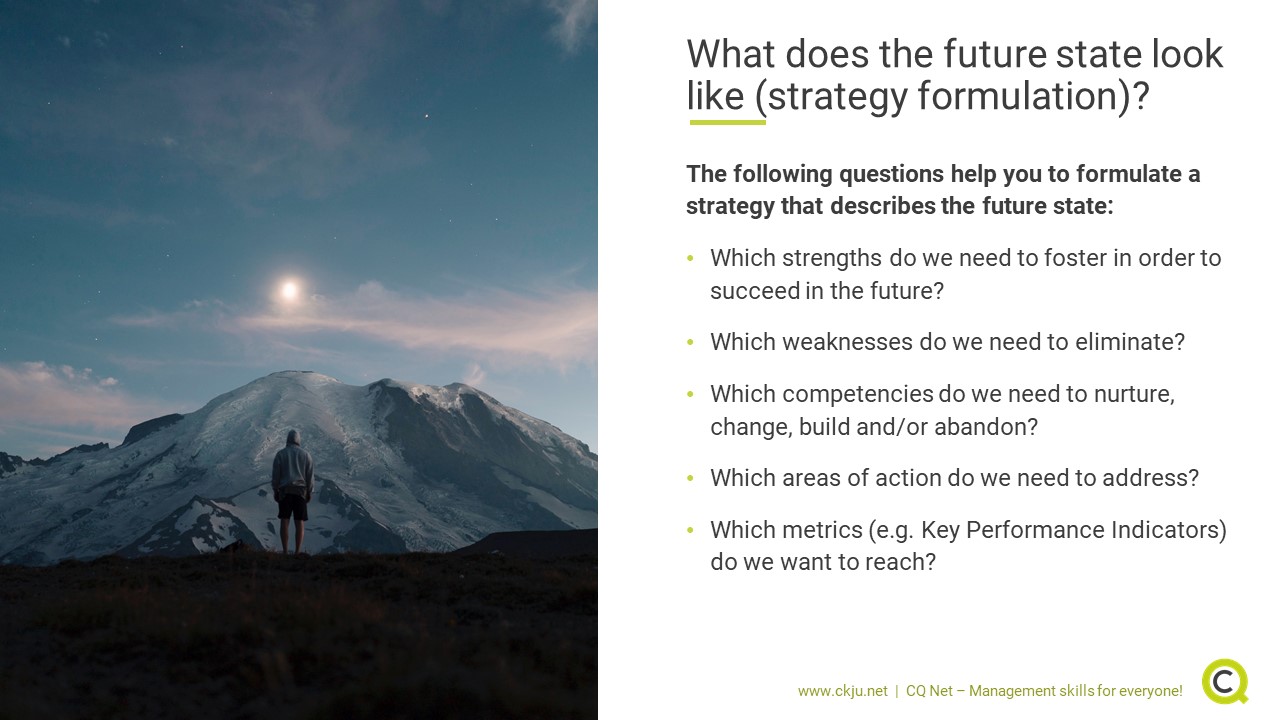- All Management Learning Resources
- Strategy development

Having a basic understanding of what a strategy is and how to develop one is an important asset for every professional. A strategy provides guidance in turbulent times; it is the starting point of all goal-setting activities and ensures that individual actions are well-aligned. In this CQ Dossier we provide you with an introduction on how strategies work and how you can develop one.
Contents
- What is a strategy?
- Why do you need a strategy?
- Strategy development: How to develop a strategy?
- Where are you now (current state)?
- What does the future state look like (strategy formulation)?
- Why is the future state important? (strategy communication)?
- How do you move from the current to the future state (strategy implementation)?
- Critical appraisal of strategy development: Holistic concept
- Key take-aways
- References and further reading
What is a strategy?
In a time where things are changing rapidly, it is more important than ever to have a “north star” in place that provides guidance and stability. When you are part of a project team, department, or any other type of organization, your north star is usually called strategy.
Until now, there has been no generally agreed upon definition of strategy (Mintzberg et al., 2005). However, on a basic level, a strategy can be defined as follows:
A strategy is a set of documents, pictures or any other type of media that describes the future state of a project, team or organization in a way such that it helps its members to move from the present state into the future state.
The term ‘strategy’ or ‘strategic management’ was mostly associated with top management and multinational organizations in the past. This narrow and elitist understanding of strategy is outdated. In addition, having a strategy in place does help you to increase organizational performance (Andrews et al., 2009).
Why do you need a strategy?
When people work together for a considerable period of time in order to achieve a shared objective, they need to have a common understanding on where to go. In most cases, you will rely on goals to make this happen. Goal-setting is a great tool to align expectations and boost performance.
However, goals are a powerful tool for short-term planning. When it comes to a time horizon of five or even ten years, traditional goal-setting will not work anymore. A lack of future orientation leads to excessive focus on temporary outcomes rather than big ideas and innovation. This is where a strategy comes into play. Let us briefly have a look at why this is the case.
A strategy gives guidance but does not determine the future
It is not only tough to predict what the future looks like in five to ten years. It is impossible. This applies even more to an environment that is characterized by a high level of volatility, uncertainty, complexity, and ambiguity (VUCA). However, this is exactly what a strategy has to do. In contrast to a goal, a strategy is less specific but more comprehensive. It provides guidance but doesn’t determine the future. In that sense a strategy can also act as a team mental model.
A strategy makes sure individual actions are aligned
People in a project team, department or organization can be incredibly busy and productive. But this doesn’t necessarily mean that the system (e.g. project, department, company) is also performing well.
The prerequisite for a high level of system performance is that all its members pull into the same direction. This is exactly why you need a strategy. It acts as sense-making tool for all members and thus ensures that individual actions are aligned.
A strategy provides stability in a dynamic environment
A strategy describes a future state in the long run in a comprehensive way without getting too specific. This makes it solid as a rock, even in turbulent times. People need such a north star to see a pattern in the noise of daily business and a dynamic environment.
Strategy development: How to develop a strategy?
Strategy development is not a rocket science. It requires you and your fellow colleagues to find answers to the following questions.
- Where are you now (current state)?
- What does the future bring (scenario formulation)?
- What does the future state look like (strategy formulation)?
- Why is the future state important? (strategy communication)?
- How do you move from the current to the future state (strategy implementation)?
Please keep in mind that a strategy per se is no what truly makes a difference. Therefore, it will be necessary to involve your project team, department or even your organizations into the strategy development process (Hodgkinson et al., 2006). You could also put it this way: Strategy communication already starts during strategy development.
PRO TIP:
You can conduct strategy development workshops with key people in your organization. This ensures that they are involved in your strategy development activities from the very beginning.
Strategy development is not a linear, top-down driven process (Ocasio and Joseph, 2005). You will go through those questions and recognize that newly gathered information will have an impact on already answered questions. This is ok and increases the quality of your strategy development process and its results.
Where are you now (current state)?
Strategy development starts with creating a common understanding of the current state. Even though it sounds straightforward, it is not. There are many examples of strategy development activities where people start to define the future state without having a good understanding of the current state. How would you define a future state and reach it without knowing from where to start?
In order to define the current state, you should take a holistic approach and answer the following questions:
- What are our strengths and weaknesses?
- What are our core competencies?
- Which risks and opportunities do we see in terms of markets and competition?
There are plenty of tools available that help you to find answers to these questions. For instance, the SWOT Analysis (Strengths, Weaknesses, Opportunities, Threats) can help you in this regard.
However, please keep in mind that such tools are just a means to an end (Gunn and Williams, 2007). Finally, it is the quality of the strategy development process that counts and not whether you applied such tools to the most extensive way possible.
For instance, it is much more important to involve people from different functions, departments, and hierarchical levels in the current state definition process. You should also rely on fact-based information rather than your gut feeling. This is were an evidence-based management approach can help you.
What does the future bring (scenario formulation)?
You cannot predict in detail how the future is going to look like, but you can develop scenarios of how it might look. The starting point of this second step is a good understanding of your core competencies or dynamic capabilities (Vivas López, 2005), relevant market trends, your competitors, and the regulatory environment.
Based on this information, you can literally paint a picture of what your environment is going to look like in five years. You should also think of alternative change paths which result in different scenarios. Please keep also in mind that your actions might have an impact on what things look like in the future. It is not that you must take the environment for granted.
As a result of the second step you should have a set of well described scenarios on hand. In combination with the current state, they are the foundation for your strategy formulation.
What does the future state look like (strategy formulation)?
Once you know where you are (current state) and how the future might develop (scenarios) step three strategy formulation starts. The key questions you should keep in mind are as follows:
- Which strengths do we need to foster in order to succeed in the future?
- Which weaknesses do we need to eliminate?
- Which competencies do we need to nurture, change, build and/or abandon?
- Which areas of action do we need to address?
Coming up with answers to these questions might require making another deep dive into on of your scenarios. I could also be that you need to initiate another set of interviews regarding your core competencies. This is what adds quality to your strategy development process.
At the end of this third step, you and your fellow colleagues should have a good understanding what has to change in order to succeed in five years from now. Next, you can start with defining the future state of your organization.
Imagine looking at your organization in five years from now and answer the following questions:
- What makes it stand out (e.g. technologies, products, products, services)?
- What do your organization’s competencies look like?
- What do the most important Key Performance Indicators (KPIs) look like?
- What is most important for your organization?
It is important to spend sufficient time for the strategy formulation process. The quality of this future state description determines how effective your strategy is. In addition, you should also involve your fellow colleagues in this task. For instance, you can this in a group disussion.
This process in not just about documenting your organization’s future state. It is about generating a common understanding about what your organization is going to look like in five years.
More specifically, your strategy could be a set of key statements that describe the future state. Each of this key statements sums up all the work done before and describes a specific aspect of your organizations future state. It described what makes your organization stand out in five years.
The way you organize your key statements is also an important property of your strategy. For instance, you can cluster them thematically to structure it in the best way possible.
Such an additional level of themes or categories doesn't just make your strategy easier to understand. It also adds another level of key statements to your strategy people can refer to in daily business and use to align their actions.
Why is the future state important? (strategy communication)?
A proper strategy development process already incorporates many aspects of strategy communication. This especially applies to strategy workshops which are discussion forums to share knowledge (Schwarz, 2009) and already set the stage for the required changes to happen. However, once your strategy is available it is important that you and your colleagues apply it in practice.
The key theme behind strategy communication is “Strategy as Practice” (Whittington, 1996). You can achieve this by relying on it, referring to it and re-iterating it occasionally in your regular communication activities. As a result, the importance of the strategy is stressed, and it is embedded in daily business.
How do you move from the current to the future state (strategy implementation)?
Having a strategy in place and relying on it will already help you to boost organizational performance. However, you should also use it to define short term goals (Sabourin, 2015) and to reevaluate on a regular basis whether you are on the right track with your journey into the future.
Critical appraisal of strategy development: Holistic concept
Strategy development is a rather broad concept that covers a wide range of evidence-based practices such as goal setting, the basic psychological needs, effective communication, transformational and complexity leadership. As a consequence, there is no single Solidity Level that can be assigned to strategy development. However, most of the concepts and theories underlying strategy development have a sound empirical basis which makes strategy development a holistic concept that can be considered as having a positive impact on organizational performance when implemented in the right way.
Key take-aways
- A strategy is a set of documents, pictures or any other type of media that describes a future state
- There are several benefits associated with having a strategy in place such as
- A strategy gives guidance but does not determine the future
- A strategy makes sure individual actions are aligned
- A strategy provides stability in a dynamic environment
- Strategy development usually involves activities to define the current state, derive scenarios, define the strategy, communicate it and implement it
- Strategy development relies on a set of evidence-based practices such as goal setting, psychological needs and team mental models
References and further reading
Andrews, R., Boyne, G. A., Law, J. and Walker, R. M. (2009) ‘Strategy Formulation, Strategy Content and Performance’, Public Management Review, vol. 11, no. 1, pp. 1–22.
Gunn, R. and Williams, W. (2007) ‘Strategic tools: an empirical investigation into strategy in practice in the UK’, Strategic Change, vol. 16, no. 5, pp. 201–216.
Hodgkinson, G. P., Whittington, R., Johnson, G. and Schwarz, M. (2006) ‘The Role of Strategy Workshops in Strategy Development Processes: Formality, Communication, Co-ordination and Inclusion’, Long Range Planning, vol. 39, no. 5, pp. 479–496.
Mintzberg, H., Ahlstrand, B. W. and Lampel, J. (2005) Strategy safari: A guided tour through the wilds of strategic management [Online], New York, NY, Free Press.
Ocasio, W. and Joseph, J. (2005) ‘An Attention-Based Theory of Strategy Formulation: Linking Micro- and Macroperspectives in Strategy Processes’, in Szulanski, G., Porac, J. F. A. and Doz, Y. L. (eds) Strategy process, Amsterdam, Oxford, Elsevier JAI, pp. 39–61.
Sabourin, V. (2015) ‘Strategy execution: five drivers of performance’, Journal of Strategy and Management, vol. 8, no. 2, pp. 127–138.
Schwarz, M. (2009) ‘Strategy workshops facilitating and constraining strategy making’, Journal of Strategy and Management, vol. 2, no. 3, pp. 277–287.
Vivas López, S. (2005) ‘Competitive advantage and strategy formulation’, Management Decision, vol. 43, no. 5, pp. 661–669.
Whittington, R. (1996) ‘Strategy as practice’, Long Range Planning, vol. 29, no. 5, pp. 731–735.
About the Author






